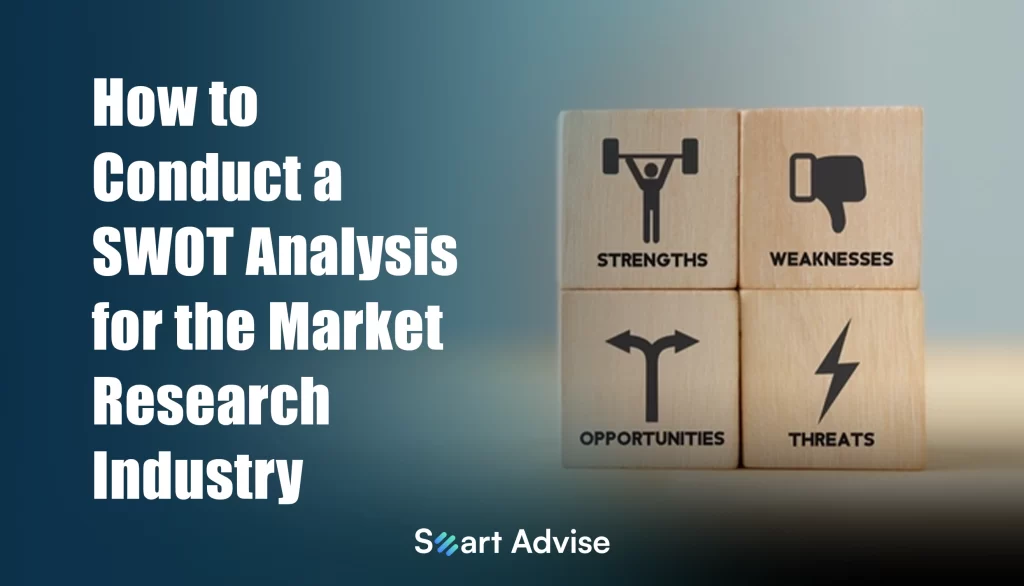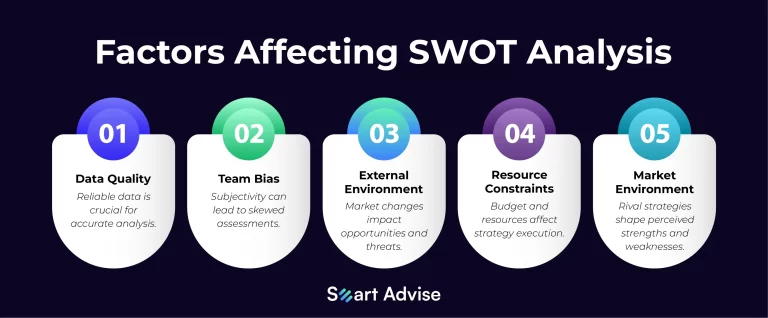
To analyze before taking action is where the SWOT analysis comes into play. Learn more about its best practices and processes.
The Market Research industry plays a crucial role in shaping business strategies and decision-making processes. To succeed with competitors, it’s essential for market research firms to assess their strengths, weaknesses, opportunities, and threats (SWOT). In further reading, we will discuss the process of conducting a SWOT analysis specifically aligned to the Market Research industry.
Understanding SWOT Analysis
A SWOT analysis is a strategic planning tool that assists firms in identifying internal and external strengths and weaknesses, as well as opportunities and threats. It provides a comprehensive view of the current state of the business and serves as a foundation for informed decision-making.
1. Strengths
Strengths represent the internal factors that give a market research firm a competitive edge. Here are some key strengths commonly associated with successful players in the industry:
a. Expertise and Talent: The Market Research industry relies heavily on the skills and expertise of its workforce. According to Statista nearly 40,000 people were employed full-time by the top ten market research firms in the United States in 2020, highlighting the industry’s reliance on human capital.
b. Technological Infrastructure: Leading firms invest in new-edge technology and data analytics tools to collect and analyze data efficiently. According to IBISWorld, the revenue of the market research industry in the United States is expected to grow at a Compound Annual Growth Rate (CAGR) of 3.3% over the previous five years. Market research revenue has reached $31.6 billion, with an expected profit margin of 10.7% in 2023.
c. Diverse Client Base: A diverse client portfolio reduces dependency on a single sector, spreading risk. A SWOT analysis can help firms identify which industries they excel in and where there’s room for growth.
2. Weaknesses
Weaknesses are internal factors that hinder a market research firm’s growth and success. Identifying and addressing these weaknesses is crucial for improvement:
a. Data Security Concerns: The market research industry deals with sensitive client data. Firms must invest in robust data security measures to mitigate risks.
b. Staff Turnover: High turnover rates can impact the quality and consistency of research projects. Addressing employee retention issues is essential for long-term success.
c. Limited Global Reach: Smaller firms might have a limited international presence. Expanding into global markets could be a growth opportunity.
3. Opportunities
Opportunities are external factors that a market research firm can capitalize on for growth:
a. Emerging Markets: The global market research industry is expanding into emerging markets. According to Statista, China’s market research earnings in 2020 were estimated at $2.88 billion USD. In the same year, Laos’ market research income was almost USD 2.5 million.
b. Big Data and AI: Using big data and AI technologies can enhance the efficiency and accuracy of market research. A SWOT analysis can help firms assess their readiness for adopting these technologies.
c. Industry Consolidation: Mergers and acquisitions are common in the market research industry. Firms can evaluate whether they should pursue partnerships or acquisitions as a strategic move.
4. Threats
Threats are external factors that can hinder a market research firm’s success:
a. Economic Downturns: Economic recessions can lead to reduced client budgets for market research. Understanding this threat allows firms to prepare for potential downturns.
b. Regulatory Changes: Market research is subject to various regulations, including data privacy laws. Keeping abreast of regulatory changes is crucial to avoid legal issues.
c. Competition: The market research industry is highly competitive, with many players vying for clients. Analyzing competitors’ strengths and strategies can help firms differentiate themselves.
Difficulties While Doing SWOT Analysis
- Subjectivity and Bias
SWOT analysis relies on employee or industry judgment. This subjectivity can introduce biases because team members may have different views on strengths, weaknesses, opportunities, and threats. Biases can cause erroneous judgments and bad strategic decisions.
To mitigate this difficulty, it’s important to:
- Encourage honest and frank communication among team members.
- Seek diverse perspectives from individuals at different levels and departments.
- Consider using external facilitators or consultants to provide an objective viewpoint.
- Base assessments on concrete data and evidence whenever possible to reduce subjective judgments.

- Lack of Data and Information
Businesses may struggle to acquire enough relevant data for their SWOT analysis. This is especially difficult when judging market trends or competing forces. Analysis may be incomplete without current and correct data, resulting in less-informed judgments.
To address this challenge, organizations should:
- Spend money on advanced methods of data collection and analysis.
- Collaborate with industry experts or subscribe to market research services for external data.
- Prioritize ongoing data collection and market monitoring efforts.
- Acknowledge areas where data gaps exist and work to fill them over time.
- Lack of Objectivity in Assessment
Internal stakeholders may have emotional or personal links to certain areas of the company, making it difficult to objectively judge strengths and flaws. This lack of objectivity can overestimate strengths or understate difficulties, affecting analytical accuracy.
To overcome this challenge:
- Encourage a culture of constructive criticism and openness within the organization.
- Use benchmarking and industry standards to provide an external reference point for assessment.
- Consider involving external consultants or industry experts to provide an impartial perspective.
- Ensure that SWOT analysis participants are aware of the importance of objective assessment and its impact on strategic decisions.
In Summary:
Doing a SWOT analysis that’s all about the Market Research industry is super important when you’re planning your strategy. By using what we’re good at, fixing what we’re not so good at, taking advantage of good chances, and dealing with potential problems, companies can set themselves up for success in this fast-paced and data-heavy industry. Reach out to us now to gain deeper insights into the market!